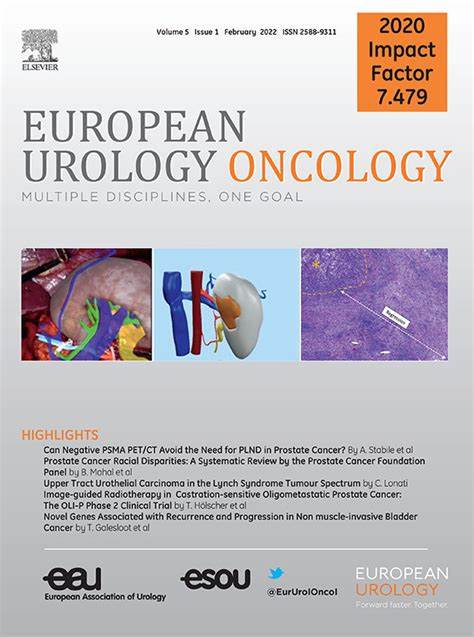使用前列腺复发成像报告(PI-RR)评分系统检测复发性前列腺癌的前列腺磁共振成像:系统回顾与元分析》。
IF 8.3
1区 医学
Q1 ONCOLOGY
引用次数: 0
摘要
背景和目的:前列腺复发成像报告(PI-RR)于 2021 年推出,旨在规范前列腺癌全腺体治疗后多参数磁共振成像(MRI)的解释和报告。该系统对图像进行 1 到 5 级评分,在单中心研究中显示出良好的效果。我们的系统综述和荟萃分析旨在评估 PI-RR 系统在预测全腺治疗后局部复发可能性方面的诊断性能:方法:遵循系统综述和荟萃分析首选报告项目(PRISMA)指南中关于诊断测试准确性的规定。检索了截至 2023 年 12 月的相关数据库。如果主要研究报告了使用PI-RR对前列腺癌复发的MRI诊断性能,则符合资格标准。磁共振成像的诊断性能采用两种不同的截断点(根据PI-RR系统,阳性≥3或≥4)进行评估。采用随机效应模型进行荟萃分析,以估算汇总的敏感性和特异性值:对16篇文章进行了全文阅读,其中6篇符合条件,共涉及467名患者。以 PI-RR ≥3(4 项研究)为复发疾病的临界值,敏感性为 77.8%(95% 置信区间 [CI] 69.9-84.1%),特异性为 80.2%(95% 置信区间 [CI] 58.2-92.2%)。以 PI-RR≥4 为临界值(4 项研究),灵敏度为 61.9%(95% CI 35.6-82.7%),特异性为 86.6%(95% CI 75.1-93.3%)。总体而言,评分者之间的一致性从一般到优秀不等:结论和临床意义:PI-RR 可准确检测前列腺癌全腺治疗后的局部复发,读片者之间的一致性从一般到良好再到优秀不等。总体而言,PI-RR 临界值≥3 显示出较高的灵敏度和特异性。患者总结:我们回顾了使用一种名为 PI-RR 的评分系统检测前列腺癌复发的 MRI 扫描效果如何的研究报告。我们发现,该系统性能良好,不同放射科医生之间的一致性从一般到优秀不等。本文章由计算机程序翻译,如有差异,请以英文原文为准。
Prostate Magnetic Resonance Imaging Using the Prostate Imaging for Recurrence Reporting (PI-RR) Scoring System to Detect Recurrent Prostate Cancer: A Systematic Review and Meta-analysis
Background and objective
Prostate Imaging for Recurrence Reporting (PI-RR) was introduced in 2021 to standardize the interpretation and reporting of multiparametric magnetic resonance imaging (MRI) for prostate cancer following whole-gland treatment. The system scores image on a scale from 1 to 5 and has shown promising results in single-center studies. The aim of our systematic review and meta-analysis was to assess the diagnostic performance of the PI-RR system in predicting the likelihood of local recurrence after whole-gland treatment.
Methods
The Preferred Reporting Items for Systematic Reviews and Meta-Analyses (PRISMA) guidelines for diagnostic test accuracy were followed. Relevant databases were searched up to December 2023. Primary studies met the eligibility criteria if they reported MRI diagnostic performance in prostate cancer recurrence using PI-RR. Diagnostic performance for MRI was assessed using two different cutoff points (≥3 or ≥4 for positivity according to the PI-RR system). A meta-analysis with a random-effects model was used to estimate pooled sensitivity and specificity values.
Key findings and limitations
Sixteen articles were identified for full-text reading, of which six were considered eligible, involving a total of 467 patients. Using a cutoff of PI-RR ≥3 (4 studies) for recurrent disease, the sensitivity was 77.8% (95% confidence interval [CI] 69.9–84.1%) and the specificity was 80.2% (95% CI 58.2–92.2%). Using a cutoff of PI-RR ≥4 (4 studies), the sensitivity was 61.9% (95% CI 35.6–82.7%) and the specificity was 86.6% (95% CI 75.1–93.3%). Overall, the inter-rater agreement varied from fair to excellent.
Conclusions and clinical implications
PI-RR is accurate in detecting local recurrence after whole-gland treatment for prostate cancer and shows fair-to-good to excellent inter-reader agreement. Overall, a PI-RR cutoff of ≥3 showed high sensitivity and specificity.
Patient summary
We reviewed studies that reported on how good MRI scans using a scoring system called PI-RR were in detecting recurrence of prostate cancer. We found that this system shows good performance, with fair to excellent agreement between different radiologists.
求助全文
通过发布文献求助,成功后即可免费获取论文全文。
去求助
来源期刊

European urology oncology
Multiple-
CiteScore
15.50
自引率
2.40%
发文量
128
审稿时长
20 days
期刊介绍:
Journal Name: European Urology Oncology
Affiliation: Official Journal of the European Association of Urology
Focus:
First official publication of the EAU fully devoted to the study of genitourinary malignancies
Aims to deliver high-quality research
Content:
Includes original articles, opinion piece editorials, and invited reviews
Covers clinical, basic, and translational research
Publication Frequency: Six times a year in electronic format
 求助内容:
求助内容: 应助结果提醒方式:
应助结果提醒方式:


